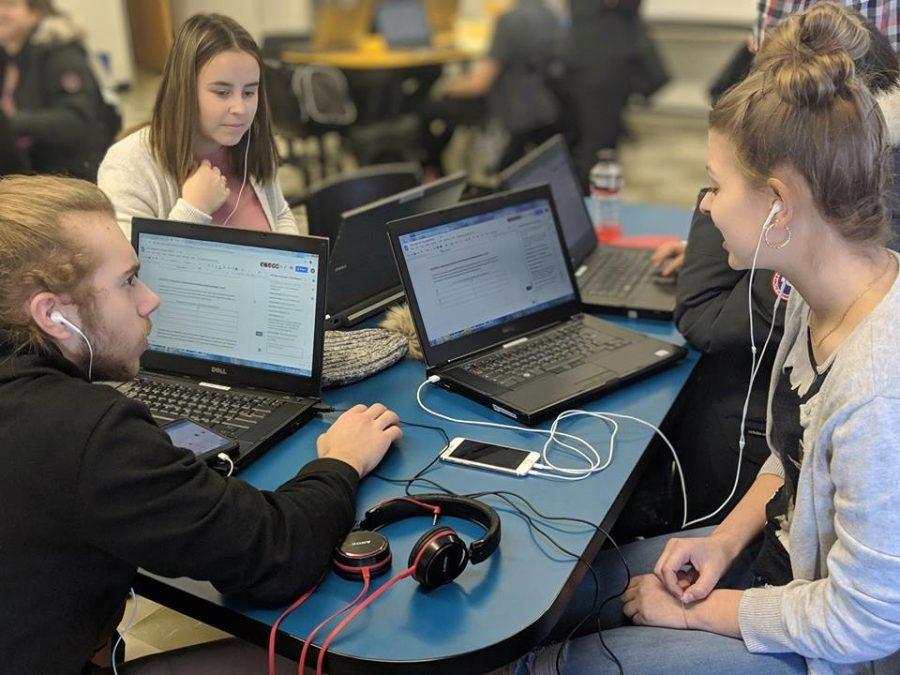A new University of Arizona digital humanities project allows French and Russian language students the opportunity to learn about various borders around the world while working with students from Canada and Kazakhstan.
“The idea was to bring young people who reside in different borderland regions in the world and get them together to talk about their experience,” said Liudmila Klimanova, an assistant professor of Russian and Slavic Studies.
Klimanova and Emily Hellmich, an assistant professor of French Studies, created the program about a year and a half ago. Both professors had similar research interest and had been looking at the idea of borders as spaces where cultures and languages mix, inspiring them to create the borderlands program.
“It’s a way for us to bring up the notion of borders and have students talk about their experiences and see how different the experience of borders can be,” Klimanova said.
Klimanova said that one of the goals for the program was to bring the younger generation together to look at the various borders and gain different perspectives.
Klimanova was in charge of overlooking the part of the program that looked at the Kazakhstan and Russian border. Throughout the program, her students would interact with students that attended Kostanay State University.
“We did a number of things; we interacted, did assignments and we did debate-like activities, asynchronous,” Klimanova said. “Students were also working in small groups. They would meet at certain times and actually have a session on Zoom and discuss their experiences with borders.”
The bigger project the students worked on was a story-telling map where students would add videos and pictures that represented their borders.
“Students would also collect different artifacts from the border in their community and then they would exchange the artifacts and discuss them,” Klimanova said. “For that we used a platform that was created specifically for this project and it allows participants to post the video on a very detailed map. You can geo-locate up to the street level, and you can connect a certain location on the map to a story, and that story was told by one of our students.”
Hellmich and her students focused their research on the northern Quebec region. Similar to Klimanova, Hellmich’s students also created a digital story that allowed them to document their experience.
“The students were given a task to go out and document a kind of border in their lives and community,” Hellmich said. “At the end of the semester, my students would create a digital story that would document all the kinds of learning that they did about borders.”
According to an article published by the UA College of Humanities, Leticia Marie Harris, a student in the program, described the similarities between the Quebec border and the borders in Arizona.
“We were talking about the types of borders that are here in Tucson, where a lot of people are bilingual in English and Spanish, with people in Québec, where a lot of people are bilingual in French and English,” Harris said in the article. “By sharing our language barriers between the two locations, we were able to find similarities.”
Working with students from another country allowed the UA students and professors a unique opportunity to interact with people that come from different backgrounds and cultures.
“It was a really great experience. As an instructor, it was really fabulous to work with the teachers we collaborated with,” Hellmich said. “The students also really enjoyed talking to the other students in Canada.”
Not only did the students enjoy interacting with one another, but it gave the students from Kazakhstan and Quebec the chance to talk to people outside of their country.
“It was a very interesting experience,” Klimanova said. “For one, we were connecting with a group of students in a small town. So for many of these students, it was the first time for them to speak to someone from outside Kazakhstan.”
RELATED: Mats help kids learn while they eat
Most importantly, the borderlands program let students learn more about how borders work and how they differ from the ones we see in Arizona. Klimanova said that she could see that her students developed a better understanding of borders as well as they became more observant in their daily lives.
“It brought new perspectives, let students see outside our own borders, and they were able to learn about regions that don’t make it on the news very much,” Hellmich said.
Hellmich hopes that program impacted her students and allowed them to think differently about the borders around the world.
“What I really hope is that my students’ understanding of borders changed,” Hellmich said. “I wanted the experience to impact them in some way and to sort of make them think differently about something we talk about locally in Tucson and nationally and to push them to expand that understanding a little bit.”
As for the future of the program, Klimanova said she wants the program to expand and become a global initiative. They are currently working on finding an area in Mexico they can collaborate with.









